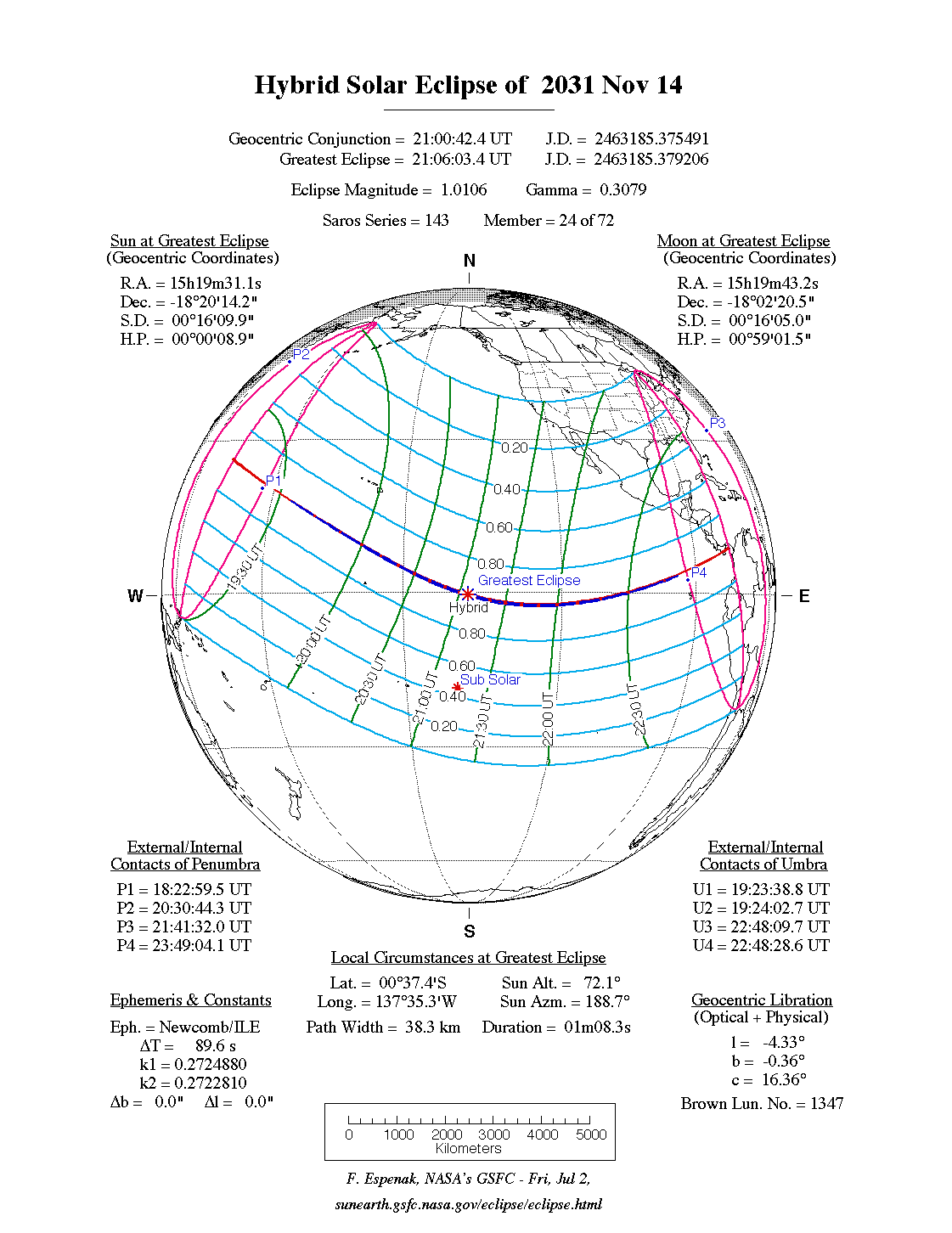A hybrid eclipse of the Sun occurs on Friday 14 November, 2031 UT, lasting from 18:22–23:49 UT. The Sun will be darkened for 1 minute and 8 seconds by a dramatic hybrid eclipse covering a narrow path at most 38 km wide. This will be a sight worth seeing, and will be visible from the Pacific Ocean and Panama. The partial eclipse will be visible from the Pacific, the southern US, and central America.
The timings of the phases of the overall eclipse
worldwide are as follows. In any particular
place it will be seen for a significantly shorter
duration as the shadow moves across the Earth:
| Partial eclipse begins: |
18:22:59 UT |
| Central eclipse begins: |
19:23:39 UT |
| Maximum eclipse: |
21:06:03 UT |
| Central eclipse ends: |
22:48:27 UT |
| Partial eclipse ends: |
23:49:04 UT |
During this eclipse the Sun will be 0.539° in apparent
diameter, 1.1% larger than average. The Moon will be just 3 days before perigee, making it relatively large.
At the start and end of the eclipse, the Moon will be
0.536°, which is smaller than the Sun;
hence the eclipse will be annular at that point.
However, at maximum eclipse the Moon will be
0.545° in apparent diameter, which is
2.6% larger than average, large enough to cover the Sun; and so a
total eclipse will be seen at that point. Thus
this is a hybrid eclipse.
The statistics page has information on the ranges of the sizes of
the Sun and Moon, and the Moon data page displays detailed
information on the Moon's key dates.
The eclipse unfortunately spends most of its time over the Pacific, but as it ends the track crosses Coiba and southern Panama, finishing over the beautiful Perlas islands as the Sun sets. At this point the eclipse will be annular, and hence not safe for unprotected viewing; the duration will be a brief 13 seconds.
Interactive Map
This map shows the visibility of the eclipse. The area shaded blue
will see a total eclipse, and the areas shaded red will see an annular
eclipse; however, near the edges of each area, the eclipse will be very
short. The bold line shows the centre of the path, where the eclipse
will last longest, so this is where you want to be if possible.
Use the zoom controls to zoom in and out; hover your mouse over any
point on the centreline to see the time and
duration of the eclipse at that point. You can pan and zoom the map to
see detail for any part of the eclipse path.
The interactive map is currently not available.
Overview Map
This map sourced from NASA Goddard Space flight Center: GSFC Eclipse Web SiteGSFC Eclipse Web Site
The primary source of all the information on eclipses presented here at Hermit Eclipse. (NASA Goddard Space flight Center)
shows the visibility of the hybrid solar eclipse. It also shows the broader area in which a partial eclipse will be seen. (Click on it for the
full-sized version.)
Eclipse Season and Saros Series
This eclipse season contains 2 eclipses:
This is the 24th eclipse in solar Saros series 143.The surrounding eclipses in this Saros series are:
This Saros series, solar Saros series 143,
is linked to lunar Saros series 136. The
nearest partner eclipses in that series are:
Eclipse Parameters
| UT Date/time (max) | 21:06:12 on 14 Nov UT |
TDT Date/time (max) | 21:07:31 on 14 Nov TDT |
| Saros Series | 143 |
Number in Series | 24 |
| Penumbral Magnitiude | |
Central Magnitiude | 1.0106 |
| Gamma | 0.3078 |
Path Width (km) | 38 |
| Delta T | 1m19s |
Error | ± 0m13s (95%) |
| Penumbral Duration | |
Partial Duration | |
| Total Duration | 1m08s |
| |
| Partial Rating | minor |
Total Rating | none |
| Sun Distance | 148007865 km (18.9%) |
Moon Distance | 371503 km (30.0%) |
| Sun Diameter | 0.539° |
Moon Diameter | 0.536° - 0.545° |
| Apogee | 02:46 on 6 Nov UT |
Perigee | 22:08 on 17 Nov UT |
| Contact p1 | 18:22:59 on 14 Nov UT |
Contact p2 | |
| Contact u1 | 19:23:39 on 14 Nov UT |
Contact u2 | 19:24:03 on 14 Nov UT |
| Max eclipse | 21:06:03 on 14 Nov UT |
| Contact u3 | 22:48:10 on 14 Nov UT |
Contact u4 | 22:48:27 on 14 Nov UT |
| Contact p3 | |
Contact p4 | 23:49:04 on 14 Nov UT |
Note that while all dates and times on this site (except
where noted) are in UT, which is within a second of civil time,
the dates and times shown in NASA's eclipse listingsGSFC Eclipse Web Site
The primary source of all the information on eclipses presented here at Hermit Eclipse. (NASA Goddard Space flight Center)
are in the TDT timescale.
The Sun and Moon distances are shown in km, and as a
percentage of their minimum - maximum distances; hence 0%
is the closest possible (Earth's perihelion, or the
Moon's closest possible perigee) and 100% is
the farthest (aphelion, the farthest apogee).
The statistics page has information on the ranges of sizes
of the Sun and Moon, and the Moon data page displays detailed
information on the Moon's key dates.
Data last updated: 2015-09-17 04:54:30 UTC.

